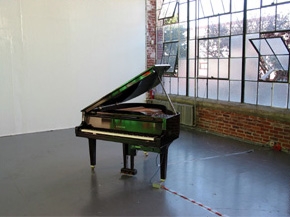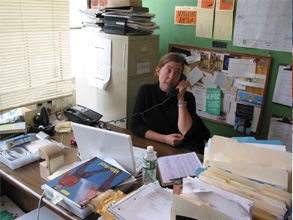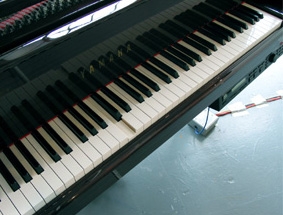Feature: Reviews
Jon Rubin & Stephen Wight
- Southern Exposure
- San Francisco
- September 10 - October 23, 2004
The Broken Music of Vox Populi:
The Conversations, an experiment in electronic audio-alchemy
I’m writing this on November 3, 2004, the day of George W. Bush’s second (or rather, first, and possibly once again bogus) election to the U.S. presidency. We, the people, have spoken, and the sounds of our collective discourse are dishearteningly discordant. Vox populi americanus desperately needs tuning and a few practical lessons in harmonic theory, or at least in playing harmoniously with others.
So any attempt, however quixotic or unresolved, to transform our American cacophony into something resembling music gets my vote.
The Conversations—a collaboration between Jon Rubin, a conceptual artist specializing in community-based projects, and musician/artist/software engineer Stephen Wight—was exactly that: an experiment in transmuting colloquial American speech into piano music. Created for The Way We Work, the 30th anniversary exhibition of the San Francisco not-for-profit artists’ space Southern Exposure, it translated conversations over SoEx’s phone lines into music via a digitally activated player piano.
The Way We Work was organized to highlight SoEx’s commitment to collaborative, community-based projects reliant on networking. But apart from the daily Neighborhood Public Radio (NPR) broadcasts onsite, most of the participating artists’ efforts were intangible, represented by documentation and/or panel discussions. [ED. NOTE: Stretcher participated in this exhibition.]
The Conversations, however, commanded an imposing physical presence both visually and aurally. An elegant Yamaha electronic grand player piano in the gallery was hooked up to three color-coded wires that snaked across the floor, up and around the wall, and into the administrative office through caller ID boxes outside the office door, connecting directly to the three office phone lines. The wires served as a visual diagram that described the work’s dynamics.
SoEx’s office is a kind of fishbowl separated from the gallery space by a large glass window. From outside the office you could see when the calls were made and who was calling. Viewed through the glass, the phone conversations taking place in the office became a performance, a theatrical event. Out in the gallery the playerless piano, a ghostly yet solidly material embodiment of live telecommunications between visible and invisible talkers, instantly turned their communiqués into audible notes: up to six “voices” producing quasi-Baroque counterpoint, Debussy-like glissandi, and aleatoric sequences reminiscent of John Cage.
At the free-for-all jam session I attended, conversations were overshadowed by other kinds of noise-making transmitted over the phone: grunts, screams, roars, someone pounding on a water cooler, someone else playing a slide whistle, still another person noodling on an accordion.
The piano went wild; it could barely keep up with all that freedom of expression. It was First Amendment music: freeform, improvisational, unpredictable, idiosyncratic, sui generis. You couldn’t hum a few bars of it if you tried. It wasn’t formally coherent, but it was astonishing and oddly pleasurable, conceptually and viscerally. Yet it didn’t begin to do justice to the nuances of intonation or inflection, let alone the meanings, of the speech exchanged across the phone lines. It didn’t sound like spoken English as music. Perhaps that’s asking too much of a project like this, but both artists involved in the collaboration—Wight especially—acknowledged that shortfall.
Rubin, who originated the concept, had speculated about other kinds of interactive or reactive pieces involving a piano and rejected them as unsuitable for this exhibition. When he finally focused on networking as the central idea of the show, he enlisted Wight—they hadn’t worked together before this—as someone with both technical and musical expertise. Wight suggested that any audio or non-audio information could be translated into piano music. The strangeness and absurdity of the possibilities inherent in that phenomenon were compelling to both artists.
Rubin and Wight decided to use the human voice, specifically real-time conversations over the office telephones, as their data input. The piece took on characteristics of other work Rubin has made, in which people who aren’t artists participate in constructing the art work, collaborating intentionally or unintentionally. “A lot of work I’ve done in the past represents daily life as a form of sculpture,” he says.
As a member of its curatorial committee, Rubin was intrigued by how much work went on behind the scenes at Southern Exposure, especially over the phones. “I was interested in foregrounding that background activity,” he says. “The gallery is in and of itself a social engine, and the networking of individuals to support the gallery is a kind of fortifying architecture. The social activity is another form of structure supporting the organization, the life force that gives breath to it and keeps it alive, although it’s invisible.”
For Rubin, The Conversations made visible, audible and tangible that institutional life force, which is literally and figuratively powered by the collective breath of people talking to each other. “In some ways it’s not so much a sculpture,” he says. “Like The Wizard of Oz, it’s about the man behind the curtain keeping the illusion afloat. It’s a metaphor for the gallery, which is about a tremendous amount of hard work that makes things seem seamless, which is like what art is. It became a metaphor visually and aurally played out.”
Wight conceived The Conversations as a musical instrument: an electronic piano retooled as a virtual wind instrument. Activated by phone conversations, it interprets those sounds—their pitch and intensity—as digital computer data via software that Wight customized from available shareware and freeware. (Wight assumed that the silences and rhythms of the word breaks would come through on their own, and would be as significant as pitch in making the musical lines recognizably generated by human speech.) This data is instantly reinterpreted into a Western musical scale and reproduced on the piano according to algorithms that Wight composed.
Wight’s post mortem on the piece is much more harsh than Rubin’s. His critique, however—aimed mostly at his own contribution—is as interesting as the work itself.
First, the piano required using Western musical scales built on semitones. This meant that the microtones of human speech had to be rounded up or down. “The semitones are the biggest problem; they’re coarse,” Wight says. “We blurred the chromatic, continuous, arbitrary frequencies of human speech, forcing them into semitone pockets, into a Western musical tradition. You lose an incredible amount of microtonal information that’s critical. I never got anything like the conversational quality of my own voice out of the piano.”
Wight also confesses that he ignored, or inverted, the advice given him by Bay Area composer, musician and computer programmer Tim Purkis, whose specialty is algorithmic composition. Purkis told him that the collection of data is unimportant; what matters is the way it’s massaged. That is, it’s not a question of GIGO (garbage in, garbage out). You can take meaningless, unordered data and turn it from a sow’s ear into a silk purse. This aesthetic alchemy is one definition of art.
Wight did exactly the opposite. He and Rubin both agreed they wanted an instrument that people could express themselves through “without crushing them with our sonic agendas.” Rubin encouraged Wight to make his own decisions on aesthetic details.
“I got a little ornery in my mind,” Wight says, “and decided that I had a stake in not producing an egomaniacal instrument that was only the voice of ME. I tried as hard as I could to be really accurate on the input side: sampling the voice, identifying the words and word breaks. I left the output as a straightforward translation. In cryptography, that’s a simple substitution code, a one-to-one swap of frequency for piano note, with duration being directly mapped to tempo of piano output.”
Wight feels that ultimately he didn’t express Rubin’s aesthetic concerns. “Jon had a strong expectation of an emotional experience that he and listeners would have when they heard the sounds coming out of the piano,” Wight says. “He expected an invisible pianist playing music, powerfully and emotionally, that if you stopped and listened to it would be completely comprised of human utterances. My approach was strongly colored by bitter pragmatism. I wanted to get anything out of the piano. What I gave him was a computer interpreting pretty damned faithfully what was happening musically on the phone lines.”
Both artists learned lessons from this piece. “Jon and I agree that we held back too much,” Wight says. “We should have made the output more juicy. I should have dolled it up more, I should have put more lipstick on it.” They tossed out a lot of ideas: triggering fragments of known classical pieces, for instance. “In the end we didn’t do any of that. We kept it as simple and generic as possible, with the naïve idea that that would allow better self-expression. The reality was, that didn’t happen because of those constraints. This was an important lesson. It wasn’t about ego. In a perverted way, I did exactly what I meant not to do, by making it too literal.”
Art, in other words, gives voice and form to the otherwise incoherent and inexpressible.
Walt Whitman heard “America singing” its varied individual songs to create a larger harmony. Right now, we hear Americans shouting raucously at each other, incapable of listening to or understanding each others’ vocabularies and points of view. Maybe, despite or even because of, its imperfections, The Conversations was a perfect reflection of our national conversations just now.




